The Burrow
You might be hearing more and more about electric cars at the moment, and maybe you’re even thinking about getting one yourself.
You wouldn’t be alone if you were: 56% of people are willing to consider buying an electric vehicle (EV) when the time comes to get a new car, while in 2020 as many as three in five Victorians said they would consider buying one, this is up from 47% the year before.1
In 2021, more electric vehicles were sold after six months than all of 2020 combined, but at fewer than 9,000 sales, that’s still much lower than most other developed countries.
One of the biggest barriers to buying an electric car, even for the most environmentally conscious drivers, is cost. As many as 77% of would-be EV buyers said the purchase price would discourage them from switching from their petrol or diesel car.2
It’s true that EVs are generally more expensive compared to Internal Combustion Engine (ICE) cars on average, as we’ll explain further on. However, that doesn’t mean there aren’t some affordable EV options out there.
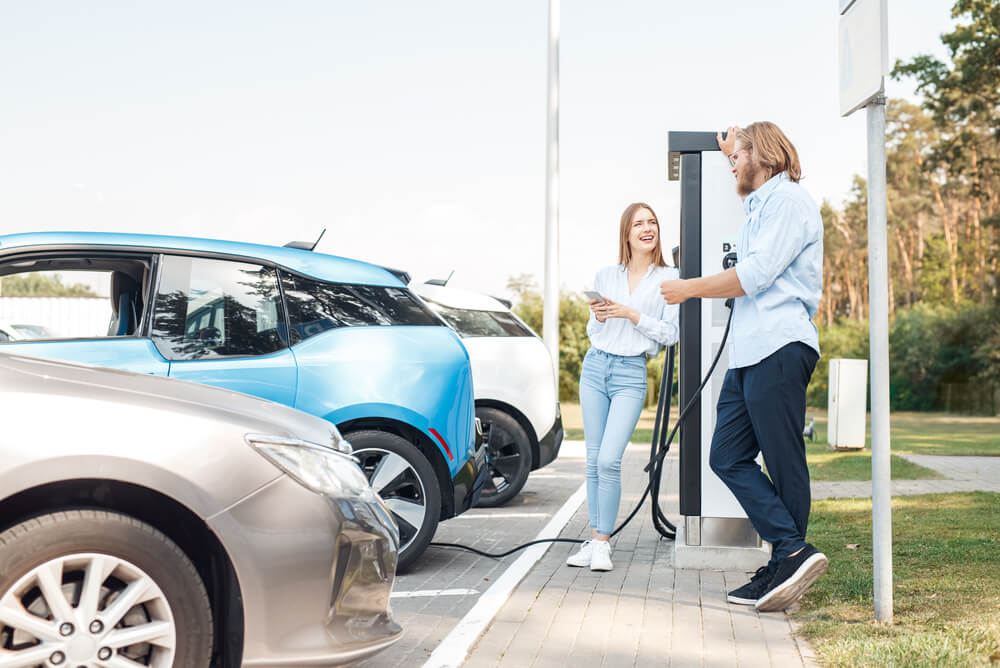
Here are the cheapest electric cars available in Australia, based on sales price data from the Electric Vehicle Council (EVC), up to June 2020.3
One of the newer EV models to hit the market, the MG ZS EV is labelled as a budget-friendly alternative to the more expensive brands like Tesla and Porsche, and at just under $44,000 driveaway, it’s currently the cheapest EV model available in Australia.
While it isn’t a high-performance vehicle based on reviews, it drives well in cities and can represent excellent value for money for someone looking to take the plunge and buy their first electric car.
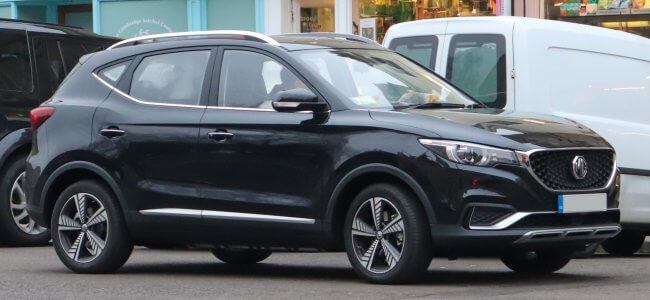
Image via Wikipedia Commons.
The second cheapest EV available is the Hyundai Ioniq at a touch under $49,000. This mid-sized five-door hatch model’s 2020 version boasts a 40% higher battery capacity than the 2019 version and, based on our data, is already the sixth most popular EV in Australia, despite being quite new.
The fourth most popular EV in Australia and the most popular non-Tesla model, the Nissan Leaf is an established electric car, as it was one of the world’s first mass-market models. It’ll set you back a similar price to the Ioniq, but it could be worth it for the large battery capacity, smooth handling and acceleration, and comfortable seating.
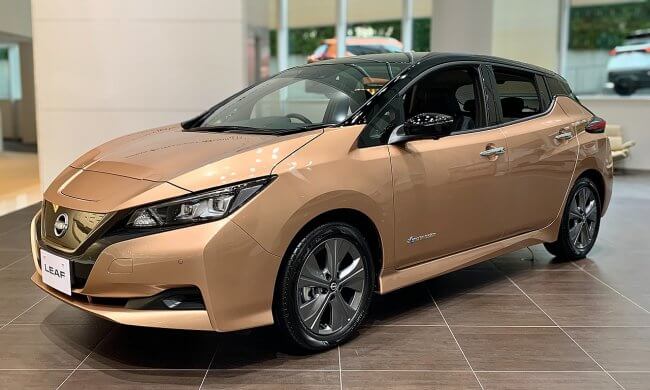
Image via Wikipedia Commons.
The Hyundai Ioniq has two models in the top five. This Premium model is a slightly more expensive option but has a longer range and improved energy consumption. One downside is the design, which some might find a bit ugly, but it’s one of the strongest EVs in the $50,000 price bracket.
If you want to blend style with energy efficiency, the electric Mini could be the way to go. It has a lower range than other similarly priced models but has excellent handling and acceleration. This makes it a great affordable option for someone who does a lot of inner-city driving.
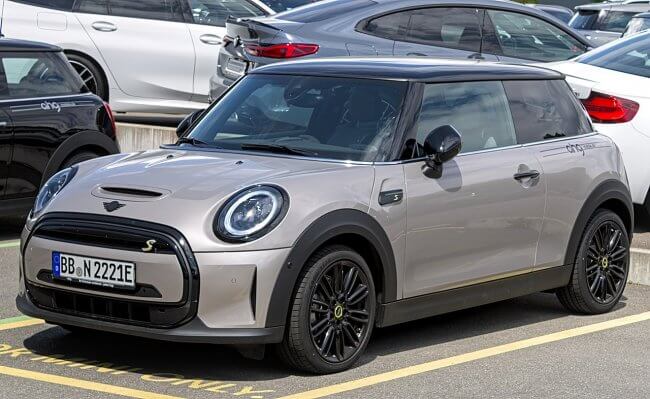
Image via Wikipedia Commons.
Other EV and hybrid models that didn’t quite make the cut as one of the five cheapest options include:
There are also other, cheaper models that you can get your hands on indirectly. For example, The Driven reports that the BYD e6 electric crossover is now on sale from just $39,999, although only a limited number of them are available.4
The EVC’s report compiled a list of each of the 31 different passenger electric vehicle models available as of July 2020 (with some becoming available by the time of writing) and their listed sale price according to the Federal Chamber of Automotive Statistics (FCAI).
While some prices may vary per person, we found that the average electric car price was in fact a staggering $139,692, while the median price (the middle sale price) was slightly lower at $129,990.
Battery electric vehicles (BEVs) were relatively cheaper with a median price of $106,400, compared to $137,100 for plug-in hybrid electric vehicles (PHEVs).
On average, electric cars are indeed currently more expensive compared to petrol and diesel cars. The most popular petrol and diesel cars insured through Compare the Market had a market value of $30,000 to $40,000, while the average market value range for EVs was $60,000 to $70,000.
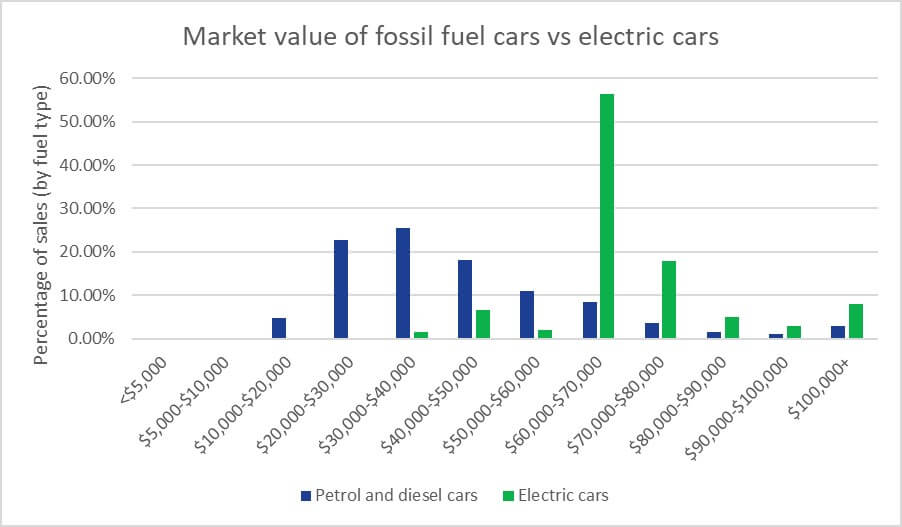
Based on car insurance sales purchased through Compare the Market between 01/01/2019 and 30/06/2021. Percentage of sales is based on fuel type.
According to the EVC’s data, the five most expensive electric passenger cars in Australia (including both battery and plug-in hybrid models) are:
Clearly, Porsche is the most expensive electric vehicle brand at the moment, with an average price of almost $260,000. Teslas will also set you back about $132,000 on average.
But if you look elsewhere, there are far cheaper models available, with many more to come. For example, Tesla also has several models available between $60,000 and $90,000.
By the end of 2022, the EVC says Australia will have 58 different electric vehicle models available.
If you think you’re ready to buy an electric car, but aren’t sure if their prices make them worth buying just yet, try the following tips to help save money on your purchase:
As Australia’s biggest car insurance quote comparison website, we can help you look for a policy to suit your electric car. By comparing your options with us, you could add your insurance savings to the savings you can make on fuel, registration and maintenance by owning an electric vehicle.6
So, compare car insurance with Compare the Market today to see how much you could save.
Image via Shutterstock